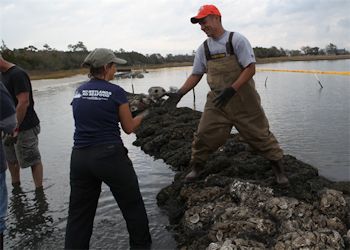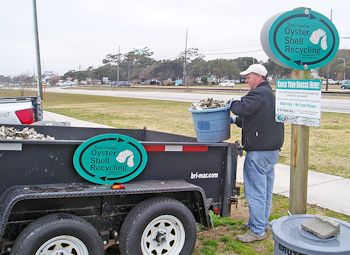Reprinted from the Tideland News
MOREHEAD CITY — Oyster season opens today, and state officials are optimistic that the 2012-13 harvest will be a good one, continuing a comeback for a fishery that is culturally, economically and environmentally important.
Mike Marshall, central district manager for the N.C. Division of Marine Fisheries, emphasized, as always, that the agency isn’t in the prediction business. But, he said recently, sampling by division staffers has turned up lots of oysters, and they’re growing faster than they were this time last year.
Supporter Spotlight
 Dermo cells as seen through an electron microscope. Photo: S.C. Department of Natural Resources. |
In addition, Marshall said, samplers are seeing “little or no” Dermo, the parasitic disease that ravaged oysters beds from the late 1980s through the early 2000s. That is one of the reasons for the comeback in oyster stocks and the oyster market as the parasite at one time was killing up to 50 percent of the state’s oysters before they even reached market size.
The fast growth, Marshall said, is welcome news after last year, when oysters “didn’t really grow much until a good while after the season started, really after Christmas.”
Although no one is sure why that happened, Marshall said the speculation is that since oysters are filter feeders, the plankton they depend on for growth might not have been the right size early in the year.
Whatever the reason, the slow growth was a bit of an anomaly, and biologists are glad to see it is apparently back to normal this year.
The prospect of a good season is welcome news to Earl Marshall Taylor, owner of T&W Oyster Bar near Peletier in Carteret County.
Supporter Spotlight
“We’ve been getting calls for the last month from customers who want to know when we’re going to have oysters,” said Taylor. “I think business is going to take off if the oysters are nice and pretty like they were last year when it (the season) closed. I feel like people are going to be standing in line to get in the door.”
There’s no way to overestimate the importance of the oyster to T&W, which opened its doors in 1971. Back then the restaurant was only open when the oyster season was in swing. The seating capacity was 38 on opening day; now it’s 250. At times over the years, the restaurant has been filled to capacity. One night – Taylor doesn’t recall the exact date – the restaurant went through 51 or 52 bushels of oysters. The average number of bushels a week was once 125 to 150.
But the 1980s weren’t so kind. Dermo hit, and in the fall of 1987 the state experienced its first red tide, a toxic alga that had moved up the coast, on the Gulf Stream from Florida. The red tide shut down shellfish harvesting for months, and the publicity harmed the state’s whole seafood industry for a long time.
 Staff Sgt. Nathyn Purganan of II Marine Expeditionary Force Headquarters Group at Camp Lejeune receives a bag of oyster shells for a new oyster reef in Stump Sound. He was part of a nine-man group that helped N.C. Coastal Federation build the reef. Photo: U.S. Marine Corps by Pfc. Jackeline M. Perez Rivera. |
 Recycling oyster shells has contributed to the rebound of the oyster harvest. Photo: N.C. Division of Marine Fisheries. |
These days, the restaurant has diversified, but the oyster is king; T&W can go through 40 bushels in a week.
Taylor gives a lot of credit to the state fisheries division. The agency and private interests, like the N.C. Coastal Federation, have emphasized restoring oyster beds and recycling oyster shells. Taylor’s restaurant and many others save the shells, which are used by the state and groups like the federation to rebuild oyster reefs. The rebuilt reefs attract baby oysters, or spat. The work seems to have paid off. Many experts think the oyster population in Pamlico Sound is at or near the pre-Dermo and red tide levels.
The increase is population isn’t only good for business and consumers but also for water quality. Oysters filter the water as they feed. One adult oyster can filter 30-50 gallons of water a day.
The oyster is also king this time of year at Queen’s Creek Seafood in Hubert in Onslow County. Owner Randy Tallman said the bivalve “is our business” in the fall.
Tallman said he sells about 100 bushels a week when things are going well, and like Marshall and Taylor, he thinks this year will be a good one.
In addition to buying from commercial watermen, Tallman harvest oysters for his business. He said he’s seen healthy ones in a variety of waters, including Bogue Sound and near Hammocks Beach State Park.
Taylor said one reason he’s optimistic about the season is that some areas were closed to harvesting earlier than usual last year. For example some areas of North River in Carteret County were closed because of the presence of “green gill,” which occurs occasionally in oysters when algae levels in the water increase.
Customers won’t buy “green-gilled” oysters, Taylor said, even though the condition has no effect on the health, quality of taste. The early closure, though, gave the oysters another year to reproduce and grow, Taylor said. The only possible downside, he said, is that some of the oysters may have grown too large for customers who prefer smaller oysters.
This year’s crop of oysters may also have benefitted from an early closure of mechanical harvesting is some areas. Using dredges and other types mechanical gear is much more efficient than hand harvesting, but the division shuts the effort down when fishermen start taking too many oysters below the legal size of three inches.
The only real bad news clouding the season outlook is the significant mortality in the lower Neuse River, Marshall said. Heavy rainfall is believed to have contributed to low oxygen levels in the water, he explained. Fish could swim away, but stationary oysters died. The Neuse is a very nutrient-rich river and is especially prone to high nitrogen levels from fertilizers that run off farm fields. High nitrogen levels trigger algal bloom. When they die, the algae sink to the bottom and decompose, which robs the water of oxygen.
 Ted Wilgis of the N.C. Coastal Federation checks oyster growth on a new reef that the federation built. |
High runoff worsens the problem by stratifying the water – lighter freshwater on top of the river’s saltwater. The layering prevents oxygen from mixing with the deeper water.
The good news, Marshall said, is that low oxygen conditions rarely occur in coastal waters south of the Neuse.
Marshall said the bottom line is that most areas that will be open to harvesting look “at least a little better than last year.”
Oyster harvests in recent year don’t approach those of “historic” levels because those records go back more than a century. “You’d have to go back 50 years or more to see these kinds of levels,” Marshall said. “It’s just a snapshot, really, and this year might be off a little compared to the past couple of years, but it’s been very good. You don’t want to say, ‘Yeah, we’re back; we’ve made it.’ But we are very encouraged.”
The numbers support the optimism. In 1987, the commercial oyster harvest totaled 1.42 million pounds, worth $2.88 million. By 1994, it had hit a low of 183,704 pounds worth $632,634, and the harvest didn’t top 300,000 pounds again until 2005, at 367,961 pounds worth $1.55 million.
Since then, though, there has been a steady climb, with harvest reaching 573,630 pounds ($2.6 million) in 2009 and then nearly doubling, to 1.04 million ($5 million) in 2010. The 2011 figures were 800,453 pounds, valued at $4.48 million.
Marshall said he expects the 2012 figures will be down because mechanical harvesting was shut down early.








